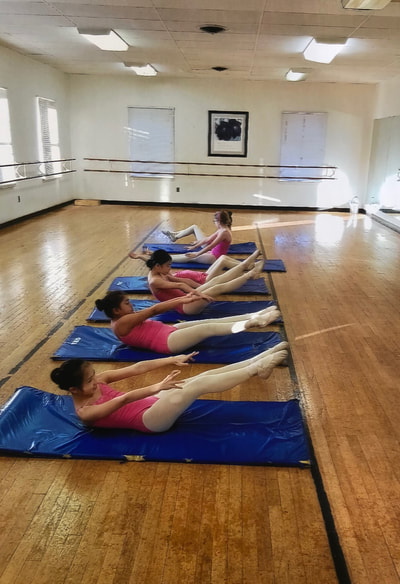Classes
Request an Evaluation Appointment Now!To find out more please email us now for details!
|
|
Class Schedule & Calendar
School Year 2023-24
(click to enlarge)
School Year 2023-24
(click to enlarge)
Youth ClassesRegistration
Registration is ongoing. Those interested in enrolling in the Falls Church School of Ballet should call (703) 532-2221 or submit the form at the top of this page to make an appointment. Curriculum
The Falls Church School of Ballet uses the classical Russian ("Vaganova") method of teaching, which has, without question, produced the greatest dancers throughout history. The method is logical and complete, and even our beginning students possess rare qualities of professionalism. From Ballet I and up, pointe work and character dance are included in the curriculum. At the younger level, beginning at age 3, children are taught the protocol and discipline of classical ballet. Pre-Ballet programs include yogic stretching, ballet mime, and, later, beginning fundamentals. Other levels are determined by age and ability. Pre-Ballet (Ages 3-5) Through the use of music and props, very young children are taught to participate in group activities and direct their imaginations. Students begin the development of musical and spatial imagery with yogic stretching and various choreographic patterns. Later, they begin simple rudimentary barre exercises. Ballet Prep. (Ages 6-7) In Ballet Prep, students are given preparatory exercises that are studied in greater detail in Ballet I. Beginning at the barre students will learn the correct stance, correct positions of the feet, and execution of movements in the most rudimentary form, along with steps that can be performed in the Kintz-Mejia Academy of Ballet (KMAB) productions. Ballet 1 - 3 (Beginning Level) (Ages 8+) In the First Year, elementary exercises are practiced to develop habits of movement and co-ordination. At first, exercises are learned facing the barre, then with one hand on the barre. For the more correct adaptation of turnout, the series of exercises are learned first to the side, then to the front, and, finally, to the back. In the Second Year, exercises that have already been learned are repeated in greater quantity and at a faster tempo. The emphasis here is on strength through the use of demi-pointe, as well as exercises on the whole foot. The Third Year, begins the study of center exercises on demi-pointe and movements en tournant (turning). There is also some acceleration of tempo. Here also begins the study of pirouettes and beats. Tuition Policies
Tuition includes all choreography and rehearsal fees. Students are required to purchase 5 tickets for each performance (Winter and Spring Concerts) at $25 each.
summer intensives
(The Falls Church School of Ballet (FCSB) offers summer sessions through The Kintz-Mejia Academy of Ballet (KMAB) that are, in their own way, quite unique. Most schools use the summer as a cash cow to give children an activity that is dance-related and fun. Our school uses the summer months with other objectives. Students in Ballet Prep to Upper-Level Senior Division (or equivalent) are eligible.
It is in the summer that our students learn such needed skills as stage make-up and performing hair styles. They also have a chance to watch and discuss videos of various ballet companies and performances. Alongside their teachers, they will learn and develop their understanding of ballet in the world today. During the summer intensives, our students learn ballet history, vocabulary, and character dance. Often, our students attend the lower level sessions to reinforce their fundamentals. These programs generate tremendous technical dance growth, as well as provide an opportunity to focus on ballet much more intensely than during the normal school year. Registration form and information are now available at https://www.kintzmejiaballet.org/classes.html (go to the tab midway down the page title "Summer Intensives 2020" and expand it, clicking on the section "Registration & Tuition") and the registration form is also available below. Informational Videos/Resources
The following page has multiple videos to assist students with several areas (e.g., buns, ribbons, shoes). When in doubt, always refer to your teacher as the primary resource. The videos are intended solely as a supplement and additional resource, as needed. Note that the videos are located on the KMAB website and will open in a separate browser window.
Click Here for Instructional Videos Makeup Information Stage makeup is NOT like normal makeup; it is intended for a very different purpose and audience. Makeup that could in any way pass for regular, daily makeup is unacceptable for the stage. It must accommodate the heavy lights and be visible to the very back of the audience. It must accentuate the facial features. It must also effectively convey the character and theme of the ballet. What may appear as excessive and inappropriate is entirely the opposite on stage. To prepare for upcoming performances, here are makeup guidelines on how to apply (boys will get specific guidance during rehearsals as to their makeup requirements). Click Here for Makeup Tutorial Handout (Handout is courtesy Vimydance in Edmonton (Alberta), Canada) |






